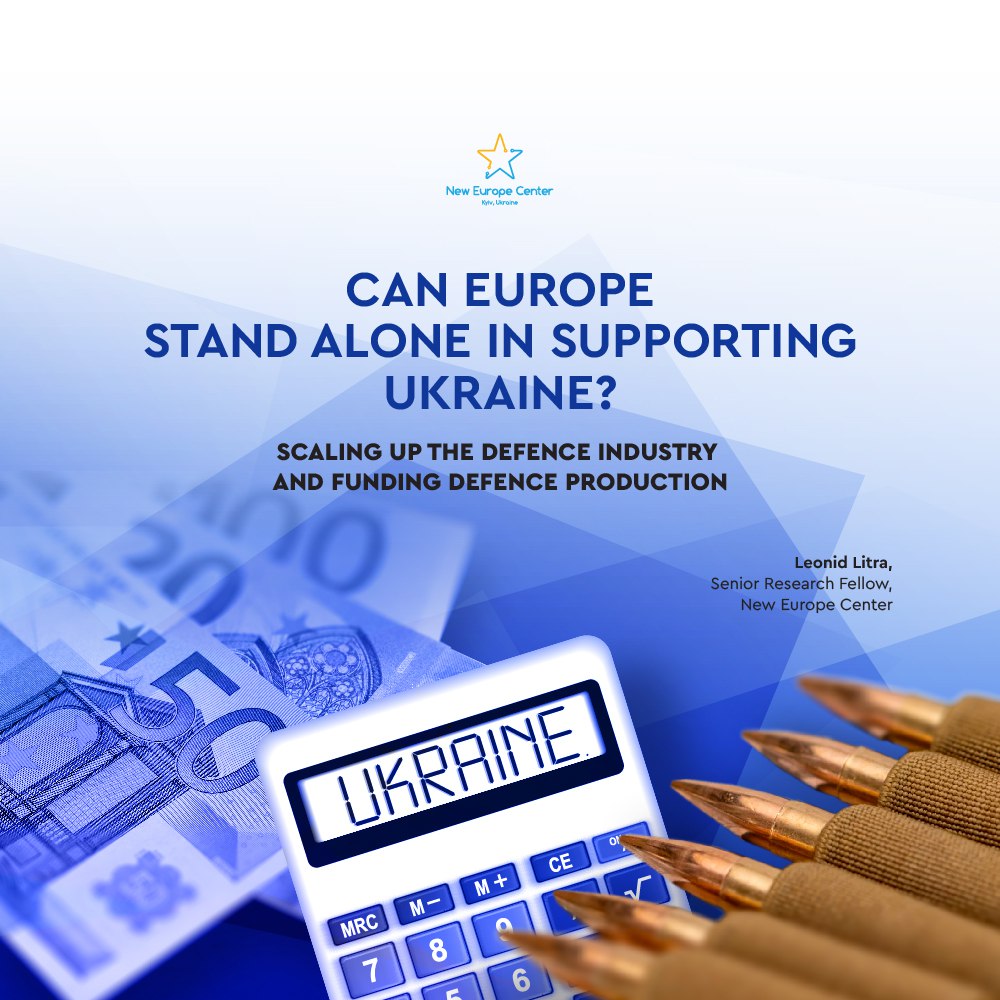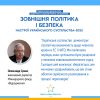
This document was first published by The Stockholm Center for Eastern European Studies on July 4, 2024. The link to the report: https://sceeus.se/en/publications/can-europe-stand-alone-in-supportingukraine-scaling-up-the-defence-industry-and-fundingdefence-production/
The report was quoted in Daily Express, UK and OBOZ, UA.
Executive Summary
In an interview in January 2024, President Zelenskyy argued that “Europe cannot support Ukraine alone without the US”, adding that Europe alone could not maintain the same level of support as that provided together with the US. How accurate is Zelenskyy’s assessment that Europe acting alone will be unable to support Ukraine’s efforts to roll back Russian aggression?
European defence production has been lagging behind Russian defence production, and the gap between the West as a whole and Russia is widening. The West produces less military ammunition than Russia alone. The European Defence Industrial Strategy constitutes an excellent first step in mobilizing defence production and addressing key challenges. To produce more, more cheaply and faster, Europe must commission as a collective, while to secure uninterrupted supplies it must place orders in the US for equipment that Europe does not produce before the US presidential election.
At the same time, the amount of funding currently allocated to implement the Defence Industrial Strategy is insufficient to generate the desired outcomes. Europe should allocate a multi-year pooled budget that would safeguard uninterrupted support for Ukraine regardless of political cycles, on the one hand, while guaranteeing an increase in Europe’s production of weapons and ammunition, on the other. Such a solution could rely on the EU budget, confiscated Russian funds or an annual contribution of 0.25% of GDP.
Insufficient funding for the defence sector and military support for Ukraine are strongly linked to the lack of a strategy for the victory of Ukraine. While the West prefers to manage the conflict in Ukraine rather than end it with a Ukrainian victory, the mobilization of financial means, political instruments and the defence industry will remain one step behind the curve. The costs of the war are already increasing and will continue to grow if Russian aggression is not rolled back. In addition, a failure by Ukraine and its partners to contain the Russian war would result in higher future costs to deter Russia and an increasingly insecure environment for Europe.
War-Related Challenges Facing European Support
With US support for Ukraine in limbo, Europe and Ukraine deepened their reflections on the extent to which Europe alone, including the UK, can assist Ukraine. Uncertainty in the US regarding the package of aid for Ukraine caused a series of negative developments for Ukraine on the battlefield, enabling Russia to use a “window of vulnerability” when Kyiv’s firepower was probably at its lowest point since the spring of 2022. The difficulties on the battlefield affected the morale of the Ukrainian army, which feared being left alone to face the Russian war machine.
The implicit strategy of some notable western states to “freeze” the line and boost the Ukrainian military so that it inflicts significant losses on Russia, which would eventually result in a negotiated settlement, does not appear to be working. The line is slowly on the move and immense Russian losses are not providing an appetite for a settlement. The lack of a decisive strategy for defeating Russia in 2022 when it was weak and unprepared has allowed the Putin regime to stabilize and turn the tide to its advantage. This threatens not only Ukraine, but also the rest of Europe. Statements by EU officials admit that a Russian success in Ukraine would not stop Putin moving forward, and that this would be only a matter of time if he is not stopped in Ukraine.
Unlike the US, the EU has no option to avoid being indirectly involved in the war, since it threatens its own territory and system of government. However, this fact has proved to be an insufficient mobilizing factor for organizing large-scale defence production that could keep the Ukrainian frontline strong. There are various reasons why a production effort has not taken place, from lack of capacity due to disinvestment in the defence industry since the fall of the Berlin Wall to extreme reliance on the US security umbrella. However, the most prominent reason appears to be a lack of consensus and political will to step in and treat Russia as a long-term threat. Good illustrations of this are the much-delayed decisions on tanks, fighter jets and long-range missiles, and the still absent budgets to support Ukraine’s military in its third year of war, combined with plenty of promises that have not been kept.
In addition to insufficient funds, coordination remains a key issue. In a recent video address, President Zelenskyy noted that not all Ukraine’s partners are fulfilling their commitments: “the weapons which help are those that are on the battlefield, not those that are promised”. He revealed the problem of weak coordination and his fight for announcements on future supplies. There is competition among the EU member states to make announcements about future (sometimes very distant) supplies, which drives up prices for military equipment and creates false expectations that there will be enough materiel in the future. As a result, some states think they should contribute in other ways since enough materiel has been pledged already, which results in significant delays. The European Commission is not always informed about planned flows of military assistance and the so called Rammstein Group is too big to share sensitive information with and schedule supplies.
Europe’s Reassessment of Its Security Role and Potential
Support from the European states has evolved significantly since the largescale invasion in February 2022. Cases such as the “5000 helmets” have been long forgotten and ambitious plans have been put in place, as illustrated by the opening of several new military production sites in Germany, France, Lithuania and Romania, among others. These new plants are essential given the high dependence of the European defence industry on producers from other continents. From February 2022 to June 2023, 78% of all the military purchases by EU member states were from outside the EU, from the US.
The EU’s ambition to provide more materiel to Ukraine has faced the stark reality that it lacks sufficient capacity, as well as increasing political ambiguity. The 2023 pledge by the EU to provide Ukraine with 1 million 155mm artillery shells illustrates Europe’s lack of preparedness. In the year February 2023 to February 2024, the bloc provided Ukraine with 355,000 artillery shells. By the end of March 2024, it had provided half a million and it is still unclear when it will reach the 1 million target. Interestingly, Kyiv has bought 340,000 shells from the EU since March 2023, which is about the same as the EU as a bloc pr ovided in the same period.
A Czech initiative, which focused on out-of-Europe acquisitions of artillery shells, was meant to show leadership in organizing supplies of shells and to compensate for the inability of the EU to fulfil its commitment. After months of debate and campaigning, 20 states pledged to fund the initiative, but it still lacked the necessary funds to purchase an initial 800,000 shells. The Czech prime minister announced that only half a million of the total 1.5 million shells identified by the Czechs could be contracted for, which means they are still fundraising for the rest.
The situation with shells is not unique. Many other promises of orders have not been kept. For instance, an announced Germanfunded contract to provide 400 MRAP armoured vehicles for Ukraine did not materialize. The first batches were supposed to be in Ukr aine in 2023 but as of April 2024 not a single unit had been delivered. The same is true in other areas, such as air defence and spare parts for equipment, all of which have a big impact on the bat tlefield. For instance, representatives of the 5th assault brigade report that of the tens of armoured vehicle handled by this brigade, only five are running, and that some are not damaged but lack the spare parts needed for maintenance. In a nutshell, NATO Secretary General Jens Stoltenberg has confirmed that NATO countries have not delivered what they promised to Ukraine, and that this has had a real impact on the battlefield.
Despite all the delays and difficulties, however, the EU’s contribution is constant and increasing, albeit that the military component is much weaker than the financial and humanitarian, which are also very important. By the most conservative calculations, in the first two years of the war the EU and its member states contributed €89.6 billion and committed to €81.9 billion in future deliveries. The US delivered €67.1 billion and by the end of the year is likely to deliver on the €60.8 billion package passed in April 2024.
Existing Measures to Address European Defence Production
To address the problems of the defence industry, the EU developed its first European Defence Industrial Strategy, which takes stock of the current situation and presents a vision for the future development of the defence industry. It seeks to address problems of defence industry production collaboratively and to remove bottlenecks in supply chains.
In contrast to the US, the EU’s size and diversity mean that the only way it can respond to the current challenge is by a cooperative approach. This will also help to create economies of scale that could reduce costs and shorten production times. Without bulk orders, it is unlikely that the EU would be able to generate enough materiel to support Ukraine.
The pressures of the current war mean that the EU strategy is already being partially implemented. The EU has funded projects in 15 EU member states aimed at removing bottlenecks in supply chains. Apart from artillery shells, however, the bulk orders intended to scale-up pan- European production have not been placed. The biggest issue is that the new strategy requires a significant amount of funding to address the shortcomings of the defence industry. The €1.5 billion allocated falls far short of the amount needed to generate the desired outcomes in terms of increasing production capacity. There are warnings that the EU strategy, although well-crafted, will fail if long- term funding cannot be secured. For comparison, Russia has allocated just one plant — the Kazan Gunpowder Plant — $800 million to increase its production.
Ukraine has been given an important role in the European Defence Industrial Strategy not only as a mobilizing factor for the relaunch of the industry, but also as part of the effort to embed Ukrainian production in the wider EU defence industry. Experts have long advocated including Ukraine in EU defence production programmes and making the EU instruments available to scale-up cooperative projects.
From a Ukrainian perspective, this was a two-way move to develop defence production projects. The Forum for Defence Industries organized in Kyiv in September 2023 gathered together 30 countries and 252 companies to discuss the possibilities for co-production and innovation, and the needs of the future defence industry. Certain EU defence companies, such as Rheinmetall and KNDS, are already setting up business in Ukraine, which should at some point result in production plants. However, without a powerful air defence, the companies will not rush to open plants in Ukraine. As a US official put it in
a private conversation, “I have 300 companies willing to sell something to Ukraine and zero companies willing to invest in Ukraine”. A notable exception might be the US arms giant Northrop Grumman, which plans to open a facility for producing ammunition in Ukraine.
The EU mirrored Ukraine’s forum by organizing an EU-Ukraine Forum for Defence Industries in May 2024, aimed at translating its strategy into practical steps by addressing the existing challenges and tailoring production plans, but mainly to bolster cooperation between the EU and Ukraine. The participation of more than 400 representatives of government and defence industries underlined the interest in creating joint ventures and integrating production — even though these are baby steps compared to the tasks facing the EU and Ukraine.
The funds allocated for scaling- up defence production will be decisive in matching and outrunning Russian production. The European economy is at least 10 times bigger than Russia’s, and the West’s gross domestic product (GDP) is about 25 times larger. However, the EU plans to produce about 1.4 million shells in 2024 and 2 million in 2025. Russia is likely to produce 3.5 million shells in 2024 and 4.5 million in 2025 –more than the EU and the US combined.
Insufficient funding of the EU defence industry is not the only problem. EU defence spending reached a record €270 billion in 2023. However, certain capabilities, such as intelligence, surveillance and reconnaissance, remain dependent on the US and it is unlikely that the EU will be able to address this issue in the medium term.
Air Defence: The Most Vulnerable Security Component
Air defence capability is a separate problem. The EU member states have insufficient air defence systems. However, from a Ukrainian perspective, their security is not at imminent risk, at least for as long as Russia is busy in Ukraine. Mass missile and drone attacks on Ukraine are inflicting destruction worth billions of euros. Since the beginning of 2024 alone, Russia has used more than 12000 glide bombs to prepare its new offensive and make territorial gains. Despite pressure from Ukraine and other allies, only Germany and Romania have agreed to provide Patriot batteries. Other countries, especially Greece and Spain are resisting the pressure, covering up with slogans such as “we will always stand by Ukraine”. The new dynamics of aggression, especially in the Kharkiv region, show how important is to have adequate air defence.
Ukraine possesses both western and soviet-era air defence systems. There is a chronic shortage of interceptors for both. Although the West could supply these at their discretion, the soviet systems will remain unused due to the lack of interceptors. To address the shortage, Ukraine is counting on the F-16 fighters planned for delivery to Ukraine in the summer of 2024. However, using F-16s as mobile air defence for engaging targets and keeping Russian fighters beyond the range of glide bombs makes it important that they are supplied with upgraded equipment and missiles such as the AIM-120D. Even with this upgraded equipment, the F-16 would help but is unlikely to be an air defence zeitenwende, or turning point. To address the issue more effectively, Ukraine must get the green light to strike the airfields and locations in Russia used to launch attacks against Ukraine.
Putting aside the non-delivery of new air defence equipment, the shortage of air defence interceptors is probably one of the biggest current issues. There is a scarcity of key interceptors for Ukraine: missiles for the Patriot system, Aster30 missiles for the SAMP/T system and missiles for the IRIS-T and NASAMS systems. This deficit has made Ukraine much more vulnerable to Russian missile strikes. Ukraine’s rate of successful interception has been 46% in the past six months, compared to 73% in the previous six months. Ukraine could now increase its rate of interception following the successful passage of the US package, and through its declared increase in the production of SAMP/T and IRIS-T missile systems. However, reaching the same rate of interceptions or even higher than before would require a constant flow of supplies, especially those which can intercept ballistic missiles, as Russia is increasingly using ballistic missiles to attack Ukraine. To ensure a constant flow of supplies, orders need to be placed now, especially with the producers of interceptors for the Patriot system, so that the current US administration can endorse the contracts before the US elections.
The success of the relaunch of the defence industry in Europe will mainly depend on the commitment of the EU member states. Some states are taking it seriously, others are not. Some states made pledges and contributed to the Czech initiative, others only pledged. In the third year of the war, some members are still not meeting the NATO 2% benchmark and some have not budgeted for the funds they pledged to support Ukraine in the framework of the security cooperation agreements. The expected zeitenwende was not intended to change Ukraine, but so far has not even been successful in Germany.
Funding the European Defence Production
It is important to make a clear distinction between the two financial tracks of the European defence challenge. The first deals with production capacity, which is addressed in the current EU Defence Industry Strategy. The €1.5 billion allocated to address expansion of production capacity is insufficient. However, the EU could unlock new funding from the EU budget that would enable more investment in production capacity.
The second track is linked to the funding of military aid to Ukraine. The EU budget cannot address this issue directly, apart from the European Peace Facility which partly reimburses the costs of the donations of member states. However, it can coordinate orders to boost capacity and create a fund at the EU level, separate from the EU budget, which would ensure continuity and the scale of supplies. This fund could be pulled together by the member states from their own budgets, for instance, using the Kaja Kallas formula of 0.25% of GDP; from confiscated Russian sovereign funds; or by issuing European defence bonds to partially fund it — or using a combination of all three.
It is not entirely clear why the EU was able to create a fund of €800 billion to overcome the economic repercussions of Covid-19 but is unable to create a fund of little more than €1.5 billion to address the bottlenecks in chain production and the creation of new capacity. The current fund for the EU defence industry represents just 0.18% of the Covid-19 fund. Ukraine therefore expects the transition to fast-track defence production to progress much more rapidly.
At the same time, an EU budget directed specifically at Ukraine’s military needs could be problematic. Consensus-based decision making has shown its vulnerability in a number of cases. Hungary has systematically blocked almost half of all EU decisions on Ukraine. Budapest has been blocking disbursement of the funds allocated through the European Peace Facility, which was created with Hungary’s approval. Future funding at the EU level is likely to be subject to the same approach by Budapest. It therefore needs to be carefully designed to avoid giving one country a power of veto.
More European states are now worried about their current level of spending on defence, but some became concerned only recently. The fact that certain European states are more scared of the election of Donald Trump as US president than of the Russian aggression in Ukraine is a worrying sign that in the third year of the war, the main trigger for relaunching the defence industry is not always Russian aggression against Ukraine.
The current strategy that Ukraine should not lose and Russia should not win does not send a political signal to defence production companies that there will be significant investment in the industry or that orders will not cease once the war is over. Even if all of it is sent to Ukraine, the current level of European defence production is not sufficient to enable Ukraine to gain superior firepower over Russia. By the end of 2024, Russia will have produced million shells and Europe 1.4 million. That is barely enough to maintain a defensive strategy in Ukraine. The situation looks similar in other areas of defence production in which Russia has the upper hand over A decision that Ukraine must win and Russia must lose would unlock new potential and new resources to be allocated to Ukraine, and thus for the defence production industry. An implicit decision by the main western actors to end the conflict by managing its escalation and not defeating Russia’s aggression does not help Ukraine.
Since there are no easy ways to mobilize enough funds to support Ukraine but also no consensus on joining NATO, on the sidelines of the NATO Vilnius Summit, the G7 supporters of Ukraine put in motion an incremental mechanism to pool funds for Ukraine — bilateral security agreements. More than 30 states joined the declaration of support for Ukraine and 16 countries have already signed bilateral security agreements pledging tens of billions of dollars in military aid for Ukraine in 2024. A similar agreement will be signed with the EU, which will anchor even more EU support for Ukraine.
These bilateral security agreements are an important element of mobilizing support for Ukraine. However, they have their limitations and do not provide security guarantees for Ukraine. The agreements are instead guarantees of security support, and only for 2024, as there are currently no amounts pledged for 2025. At the same time, however, the agreements are forming a ‘coalition of the willing’ to provide substantial military support for Ukraine. In the long run, the partner countries could develop new elements of security support for Ukraine within the current agreements, as these are flexible and can be adapted to different situations.
Lack of a Strategy for a Ukrainian Victory
The current division in Europe between the peace camp and the justice camp is not helping Europe to mobilize sufficiently. Europe will remain the most powerful instrument for moving things forward at home but also keeping Ukraine’s morale high for the fight. Ukraine has a problematic situation regarding manpower, which is why the state adopted a new mobilization law, albeit delayed, and reduced the mobilization age from 27 to 25 to alleviate the situation and prepare for a long war. However, the lack of ammunition and fear of being left alone have directly impacted the morale of Ukraine’s defenders. To reverse course, Ukraine desperately needs to feel that military supplies will be constant or increasing and not subject to electoral cycles, political volatility or competing interests. A feeling of having reliable military supply for years to come also serves the goal of settling the conflict and changing Putin’s calculations. Currently, there are no incentives for Putin to negotiate anything as he does not face any significant difficulties or immediate threats, especially given the unstable nature of western support for Ukraine
The only change in the narrative to challenge the Russia strategy was a message from President Emmanuel Macron, underlining that he does not exclude anything, including putting boots on the ground in Ukraine. Deploying military instructors to Ukraine would speed up training for Ukrainian troops and anchor western support even more there. The Russian reaction showed that Macron-style communications are very disturbing for its goals in Ukraine. Comforted by the escalation control strategy of the West, Russia can do whatever it likes in Ukraine. Macron’s ambiguous statements on the possibility of sending troops help Ukraine to change Russia’s calculus on its limits of action in Ukraine.
Increased production would also help to tackle the question of whether Europe is able to support Ukraine and increase its military power at the same time. Current data suggests that only one is possible. The increase in capacity will create possibilities to address both Ukrainian and European needs.
The effort to stand alone in supporting Ukraine would be financially burdensome for the European states. However, these burdens should be compared to the potential costs of Ukraine losing the war, which would be likely to require more spending to enforce deterrence and deal with refugees, but would also be likely to result in insecurity and political volatility, as well as increased tensions in society.
European support is also fragmented and unevenly distributed, creating additional tensions, such as the current French-German debate which is not productive either for Ukraine or for the EU member states. The idea of Kaja Kallas to commit 0.25% of GDP to help Ukraine will be important for bringing about just and balanced support.
Defence coordination, which is addressed in the current strategy, is an important development. The creation of thematic coalitions within the Ramstein Group is helping, as are the bilateral security agreements that Ukraine is currently signing with the countries that joined the G7 framework declaration. Ukraine expects there to be collaborative projects able to place orders in bulk that would also involve Ukraine. This is important for future localization of production and thus the integration of Ukraine into the production cycle. The current EU strategy offers such opportunities but the situation on the battlefield requires a more expedited answer to Russian aggression.
At the same time, it will be important to keep certain defence initiatives out of the EU framework, given the veto power of countries that are constantly weakening the EU’s ability to help Ukraine. Russian “Trojan horses” have been one of the most important elements in sabotaging support for Ukraine. For the EU to work more smoothly and have a high degree of agility, it must re-examine its own regulations. Current spending and public procurement rules undermine the EU’s capacity to mitigate the effects of war inside the EU and be resilient against various hybrid attacks, and reduce its capacity to help Ukraine. Under current regulations, the EU is unlikely to be able to move to a war economy even if it agrees to take this step.
Localization of Defence Production
Given its current and projected capacity, the EU is seen as an increasingly powerful player in the production of artillery shells, where it can make a difference in the medium term, especially in a war of attrition scenario. The EU could also make a difference in the production and supply of land vehicles if it manages to place a large order and fast-track production. Ukraine is already transitioning to western equipment and new supplies will only solidify Ukraine’s transformation and stability, especially if maintenance is streamlined.
Ukraine’s own relaunch of defence production has been problematic due to the security, risks but also due to financial issues. Of all the defence production in Ukraine, that of drones stands out as a highly successful industry. Ukrainian drones were able to save the Ukrainian front line in the hardest of times when it was left almost without ammunition. Drone productionin Ukraine has been effective since it is in the hands of private sector entrepreneurs who, unlike the Ukrainian state, are agile, non-bureaucratic and most importantly use decentralized production.
Ukraine aims to produce 1 million drones in 2024, which would in part compensate for the shortage of ammunition. At the same time, Ukraine’s digital minister has noted that Ukraine can produce 2 million drones a year if the financial support is provided by the West. Drone production capacity has recently increased significantly but the lack of resources and the security environment mean that private companies are not able to scale-up their production. In this respect, orders placed in Ukraine by supportive governments will help the industry survive, provide faster drones and support the economy in Ukraine. Denmark and Canada have already provided funds to support local drone production ($28.5 million and $2 million), which will scale-up the industry and help the Ukrainian war effort. The European defence industry could help Ukraine but also benefit from making investments in Ukraine’s production. It could also help Ukraine switch to more sophisticated production as First Person View (FPV) drones are likely to lose their importance in the medium term unless they modernize in such a way that they can play new roles.
Ukraine is currently working on “soft” entry for military companies. The Ukrainian authorities are starting to produce spare parts based on licensing, which will then lead to the creation of maintenance, repair and overhaul facilities, creating the conditions to start full-fledged production.
What Still Needs to Be Done?
SHORT TERM
- Adopt a strategy that enables Ukraine to win. The absence of a strategy that would enable Ukraine to win has been significant for the mobilization of funds, political instruments and the defence industry. The fact that the West has not been united in adopting a strategy that would lead to a Russian defeat in Ukraine prevents Ukraine’s supporters from taking bold steps to produce and supply Ukraine with what it needs. Any such strategy should address the restrictions imposed on Ukraine with regard to the use of western weapons on Russian soil.
- Place joint defence orders to scale-up production and speed up The placing of large pooled orders is another element that must be urgently addressed. Joint purchases can create economies of scale in the defence sector by allowing long- term planning on production, which also reduces the political volatility caused by election cycles. Placing joint orders will require use of the cluster leadership in thematic alliances that has been created for air defence and drones, and so on. This would help improve the planning and coordination of production and procurement.
- Contract deficit material and services from the US before the presidential election. Scaling-up the defence industry will take time, especially in areas in which the EU has a high dependence on the external market. Important defence articles used in Ukraine, such as interceptors for the Patriot system, rocket artillery for HIMARS, aircraft munitions and artillery ammunition, are produced in the US. European states will need to place orders in the coming months so that US supplies are approved by the incumbent administration. The same is true of commercial arrangement for intelligence, reconnaissance and surveillance. If Donald Trump is elected president, it is unlikely he would challenge existing defence production contracts from which the US benefits.
- Increase funding for the European defence industrial strategy. The European Defence Industrial Strategy is helping to increase production in a more organized and consistent manner. Collaborative projects and addressing production bottlenecks in supply chains have given the EU an opportunity for a quick restart of defence production. Without a clear political green light and long- term increases in funding, however, European industry is unlikely to have enough production capacity to be an important player.
- Cut the red tape for defence acquisitions to increase agility and Military orders in Europe are subject to an over-regulated environment that does not allow for spending to be fast-tracked. This reduces the EU’s agility and ability to react to change. Cutting red tape for specific defence needs is essential to catch up with the reality on the ground. Thus far, the EU has been on average one year behind Russia in the production of basic materials such as artillery shells.
- Confiscate Russian sovereign assets to invest in the defence Since many opportunities in the defence industry are constrained by the lack of available funds, European states will need to consider funds that are already available. Confiscation of core Russian sovereign assets remains the most significant and morally correct source of funds that could work to defend the continent. Part of these confiscated funds should be invested in the joint production of defence articles to provide European (including Ukrainian) industry with much-needed long- term funding.
MEDIUM TO LONG TERM
- Integrate Ukraine into European defence production. In the long term, Europe’s reliance on the US must be addressed, since the US is above all looking to the Indo- Pacific region while Europe has a direct threat on its continent. In addition to basic military goods, Europe has a powerful base for producing advanced technology materiel. Ukraine needs to connect to the production cycle and become part of production. Small- scale, decentralized production should take place in Ukraine not only to integrate Ukraine into the European defence industry, but also to facilitate the logistics of supply, licensing, spare parts and maintenance. Ukraine’s current capabilities, especially in drone production, are not fully used. The examples of Denmark and Canada, which have allocated funds for drone production in Ukraine, should be followed by other states. Investing in Ukraine’s drone production provides drones for the Ukrainian military and supports the local economy.
- Adopt a multi-year financial plan to support Ukraine. To strengthen the EU’s multi-year support to Ukraine, Europe must embark on medium- to long-term planning. Current commitments on defence support are clearly defined for 2024 in the security agreements with major European players. However, exact amounts should already be being budgeted for 2025 and The €50 billion Ukraine facility is a good example of long-term planning that could be replicated in the defence sector. If this is not achievable at the EU level, then the 0.25% of GDP proposal would address this issue well.
- Deter Russia through investments in defence production. Current projections on the production of defence materiel forecast that Europe acting alone can only meet Ukraine’s defence needs for a limited number of defence-related articles. Greater investment is needed to enable Ukraine to push back on Russian aggression in the medium term. However, production also needs to be capable of deterring Russia after the war.
- Invest in European defence to keep the US engaged. Increased European defence supplies to Ukraine also make the case for a greater contribution from other states, including the Although strategically Europe should be able to defend itself, help from the US, especially in the current context, is very important. Trump has recently reinforced his view that if he is elected, the US could help Ukraine — but only if Europe spends more than the US. This is in fact already happening, albeit not significantly more. Trump’s ideas are increasingly shared in wider political circles on Capitol Hill and fading support from the US is likely regardless of who is the next president.
PDF-version is available here.







